
According to Thanksgiving lore, the pilgrims were actually forced to land on Plymouth Rock — they were low on beer you see. Back in those grand old days (the roaring 17th century), beer was a dietary mainstay (the beverage being a not-very-alcoholic concoction drunk in impressive quantities during the Colonial era). On a long ship voyage, beer would keep longer than ordinary water.
Like many great things, Thanksgiving has a rich tradition soaked in beer. This time of the year is made for celebrating, and nothing says socializing and solemnizing more than a brewski between friends and family. But do you know what makes big toasts even more personal during Thanksgiving season? If you actually made that fine bottled beverage yourself. So, in the spirit of both thanks and giving, we reached out to a few of our favorite craft breweries around the country to get their advice on the ultimate homemade treat — homebrewed beer. From Hawaii to Delaware, craft breweries like New Belgium, Dogfish Head and Founders offered up excellent insights for homebrewers everywhere. We thank them all for taking time out of their busy holiday schedules to participate, and we wish everyone in the craft brewing world a happy and safe Thanksgiving holiday. Here we go…
Happy, healthy yeast
Andy Mitchell, brewer
New Belgium Brewing Co. (Fort Collins, Colo.)
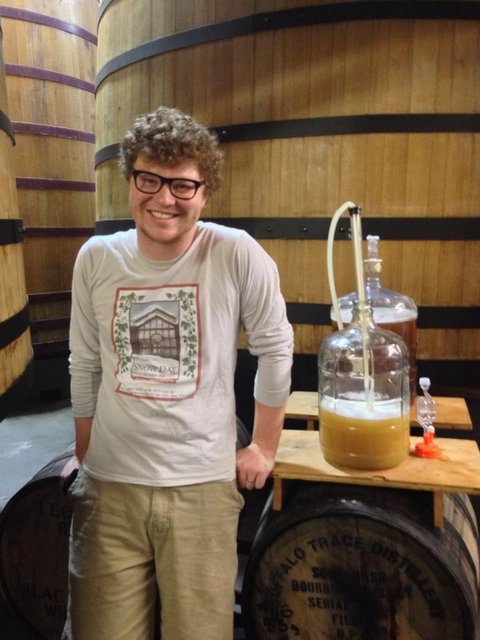
The first step to making amazing beer, commercially or at home, is to have happy, healthy yeast. Make sure you are pitching the right amount, and most importantly, be sure to control the temperature during fermentation. To ensure proper pitch rates and high viability at home I really like to make a starter when using liquid yeast. Mrmalty.com is an excellent resource for learning about how much you should be pitching and how big of a starter to make. Also, because fermentation is exothermic, it’s important to keep an eye on fermentation temperatures or the yeast will get out of control and can create some less than desirable flavors. If you don’t have a room that stays pretty cool [around 60 F would be okay for most American and English styles], consider putting your carboy in a water bath and swapping out frozen water bottles as well as draping a T-shirt over the carboy for some bonus evaporative cooling. I’ve used a 15-gallon plastic tote for this in the past. The ultimate solution to temperature control is using a refrigerator or freezer and a temperature controller to make a fermentation chamber. This way you can track the temperature with a probe attached to the carboy and use the fridge or freezer to cool the carboy if it gets too warm. There are some dual-stage controllers that allow for heating as well as cooling if you have your fermentation chamber someplace cool or if you need a bit of extra heat for brewing Belgian styles.
Change one aspect at a time
Jamie Floyd, founding brewer and co-owner
Ninkasi Brewing Co. (Eugene, Ore.)
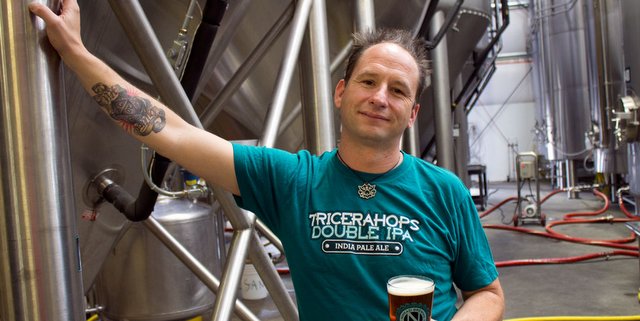
It is important when trying to perfect your process to change only one thing at a time. For instance, if you want a beer with a good amount of caramel flavor and a robust hop profile but you make a beer that has no caramel flavor and isn’t hoppy enough, the best thing to do is change one aspect of the beer at a time so that you can mark the progress. If you make more than one adjustment at a time, you may not know what you did right or wrong for the next brew. If you change both aspects and then do not like the results, it is hard to determine what happened because you changed multiple aspects. By addressing each issue separately, you actually learn what the adjustment did rather than guess what step affected what result. You might do the right thing with one aspect and wrong with another, and think they both were wrong.
No two snowflakes are alike

Sam Calagione, founder and president
Dogfish Head Brewery (Milton, Del.)
Don’t get discouraged if every batch doesn’t turn out perfect. As long as you follow the proper steps, most batches will turn out perfectly drinkable and in time, you will go from making good to great beer. You’ll also discover that no two batches will taste exactly alike. No two snowflakes are exactly alike either, but in their own beautiful way each is perfect. What will remain constant is your ability to reflect your own passion and tastes in the beers that you make.
The brewing state of mind
Rob Widmer, co-founder
Widmer Brothers Brewing (Portland)

Homebrewing has come a long way since [brother] Kurt [Widmer] and I first got started. However, one of the most important facets of homebrewing will never change, and that’s the homebrewer’s psyche or mentality. Homebrewers shouldn’t get caught up with their personal expectations of making a really great beer, or fear that he or she might have made something bad. There is so much good craft beer on the market that sometimes people stress out about making beer comparable to professional breweries. You have to remember to always have fun with it and not stress out too much. Some of the most interesting beers I’ve had over the years have come from homebrewers, so be persistent, have fun and don’t fear the process. The other piece of advice would be to join a local homebrew club or find like-minded people to brew with. Here in Portland we have the Oregon Brew Crew, and there are local clubs almost everywhere. There is a wide range of experiences at most clubs, meaning no one should be intimidated to join. Most experienced homebrewers like company on brew day, and beginners can learn a lot from watching an experienced person in their process. It’s a great way to see how someone else does it and learn some tricks along the way.
Pair food with your homebrew
Garrett W. Marrero, founder and owner
Maui Brewing Co. (Lahaina, Hawaii)

I always look at the holidays as a great opportunity to experiment with beer and food pairings. I often consider which beer to pour with what menu item weeks in advance. For the avid homebrewers that enjoy impressing in the kitchen, consider integrating your brewing skills into your menu this year. Using not just beer but your brewing ingredients in the menu opens a whole new world of flavors and pairing opportunities. This year, Thanksgiving is a potluck and I’m on cranberry, turkey and dessert duty. I chose to make turkey confit this year. It doesn’t get much better than turkey baked in a gallon of duck fat. I’m pairing that with Berliner Weisse in order to offset the delicious fats with scrubbing bubbles and tart flavors. Instead of serving the average cranberry sauces, I’ll be simmering fresh cranberries in witbier, cinnamon, adobo peppers and a serrano for heat, and Belgian candi sugar for sweetness. Now for dessert, consider augmenting your baking flour with your favorite malted barley milled into flour. This year, it’s coconut porter cream pie done with Munich and Maris Otter malts in the flour. We’ll pair dessert with two beers this year — imperial stout and bourbon barrel-aged trippel. Happy Thanksgiving and Mele Kalikimaka!
Bittering and aroma hops
Bruce Taub, president
The Fat Cat Beer Co. (San Diego)
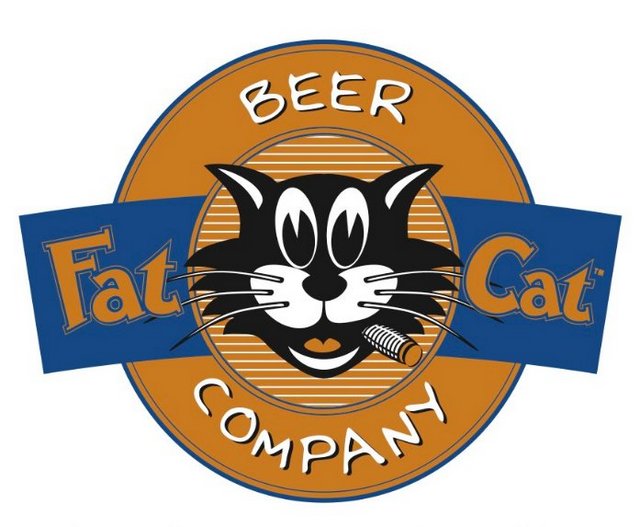
The varieties and quantities of hops used by the homebrewer will determine the dominant characteristics of any beer-type that you are brewing. Hops not only give the beer its bitter character but provide much more — aroma and flavor in varying degrees depending of the type of hops used and at what stage they are added in the brewing process.
Bittering Hops (First): Bittering hops are added to the kettle at the beginning of the boil and are used primarily for bittering and microbiological stability. Since alpha acid [a.a.] is the primary bittering ingredient of any hop, it follows that brewers may use a high alpha acid hop as their first hop — some even use hop extracts as the first hopping. This can be up to 80 percent or less of the total a.a. used in the brew. Some good, modern bittering hop varieties are Columbus at 15 percent a.a., Millennium at 15 percent a.a., Apollo at 16 percent a.a., and Chinook or Galena both at 12 percent a.a. If using hop extract as the first [bittering] hop, the one to use is Redihop at 30 percent a.a. Much of the flavor and aroma of these first hops will be lost during the long boil, but the bittering component will stay in the beer — i.e., you will achieve a higher a.a. utilization. Note that these high alpha acid bittering hops will give your beer a bit of harshness and poor aroma if used alone. This can be overcome by the addition of aroma hops.
Aroma Hops (Late): Conventional wisdom says to use aroma hop varieties late in the boil since a short boil will preserve their flavor and aroma and impart it to your beer. Aroma varieties can be used at 20 percent or more of the total a.a. charge. The aroma hop varieties Saaz and Hallertau Mittelfrueh (with their classic “noble” aroma) and Fuggle generally have low a.a. and are more expensive due to lower farm yields and disease resistance. Some continental pils have been known to be hopped with 100 percent noble hop varieties. Then we have those hops which contribute the floral, citrus aromas to beer and ale — Cascade, Citra and Amarillo. Late hops can be boiled for as little as 5 minutes but no longer than 15 minutes.
Enemies of success
Jason Buehler, head brewer
Oskar Blues Brewery (Lyons, Colo.)
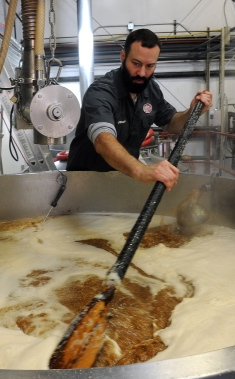
One of the biggest mistakes I see home brewers make is not protecting their beer from its natural enemies. It’s pretty easy to keep your beer away from light and oxygen, but a common mistake that occurs too often is allowing either to degrade your homebrew. Light struck hop off-flavors can occur pretty quickly. If you don’t believe, me pull two pints the next time you’re sitting at your favorite outdoor patio and keep one in the shade and one in direct sunlight for a few minutes and do a simple side by side taste test. It’s very rare to find homebrew in a green or clear glass bottle, but if you are using them, please don’t. Also, if you’re not covering your carboys, throw a towel around them at the very least, or if you have a wife as amazing as mine she’ll craft you a nifty little carboy cover with beer-themed fabric.
Oxidation is in my opinion the number one homebrew killer. Too often I see homebrewers racking their beer into a secondary carboy or racking their beer into a keg without purging the vessel with CO2 first. If you’ve never purged a vessel before it’s quite simple: Fill it with CO2, preferably from the bottom up. The CO2 is heavier than air and will separate itself and sink to the bottom. You can smell the CO2, which will indicate when you’ve gotten all the oxygen out. If you don’t keg your beer and don’t have a CO2 setup, I think it’s a worthy investment to get one. Plus, it makes the switch to kegging a little less costly, and if you’re going to be a long-term homebrewer, you will make the switch to kegs eventually.
Your yeast needs oxygen
Gary Glass, director
American Homebrewers Association (Boulder, Colo.)

Treat your yeast well, and it will be good to you. Yeast needs oxygen to build cell walls — an important function for cell growth. I remember the quality of my homebrews jumped when I started aerating my wort. Aerating wort is simple: Shake your carboy or vigorously stir the wort in a fermentation bucket for five minutes or so when you pitch your yeast. This will make a big difference in yeast health and ultimately the flavor profile of your homebrew. If you use dried yeast, follow the instructions on the package to properly rehydrate the yeast prior to pitching into your fermenter. Making yeast starters for liquid yeast to build up a large quantity of active yeast will also greatly improve your beers, particularly if you are making beer with original gravities of 1.060 or higher. Starters are made by mixing water with dried malt extract [100 grams of DME per liter of water] and a little yeast nutrient, boiling for 10 minutes, chilling to pitching temperature, then adding yeast. Let the starter go for a day or so, stirring or shaking frequently to aerate and keep yeast in the solution. You can use brewing software or free online yeast calculators to determine the appropriate starter size for the beer you are brewing.
The philosophy of homebrew
Dean Coffey, brewmaster, yeast rancher and co-founder
Ale Asylum (Madison, Wis.)

Is brewing art or science? This has been debated for decades. I think that brewing is both art and science. But there is, and always has been, a lot of overlap between the two. If you think about it, both art and science require discipline. No scientist — math, chemistry, biology, physics — got were he or she is without a lot of practice and discipline. The same can be said for an artist — painting, writing, music. It takes lots and lots of practice. The same is true for brewing. When homebrewers ask what they can do to make their beer better, I always say: Brew more. Brew 100 more batches. Then, when you see me, you will have specific questions. You will start to understand what you don’t understand. As far as specific advice, always homebrew by the CRIS Principal: Clean, rinse, inspect and sanitize. If the first inspection shows a hint of residue, keep cleaning, rinsing and inspecting until it is clean enough to sanitize. My other piece of advice is to invest in a good quality wort chiller or heat exchanger.
Cleanliness means awesomeness
Matthew O’Hara, brewmaster
Beau’s All Natural Brewing Co. (Vankleek Hill, Ontario)

I’d recommend a really comprehensive approach to cleaning and sanitation. This aspect of brewing can’t be stressed enough both for the homebrewer and professional brewer. A really obvious standard is that if a piece of equipment doesn’t look completely clean, it isn’t. Left over soil after cleaning is a harbor for bacteria and sanitizer will not perform adequately on surfaces that have bio films or caked on proteins. Many times I have witnessed brewers take meticulous steps to assure sanitation through a process only to drop the ball at a critical control point further down line. A good example of this might be a lack of attention to hand washing and the sanitary condition of caps during bottling.
Get educated
Damon Scot, brewmaster
NoLi Brewhouse (Spokane, Wash.)
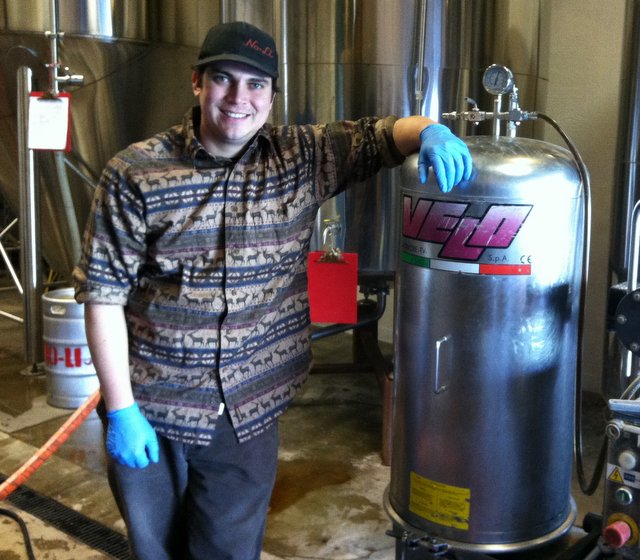
The best way to be a better brewer is to educate yourself as much as possible. There are many great homebrewing books out there, but I recommend digging deeper and reading the plethora of professional brewing literature available. The Brewers Association has released a series called the Brewing Elements Series which focuses on the four main ingredients. Also, have a look at Brewing Yeast & Fermentation, by Boulton and Quain, the Bible of brewing microbiology. Malts and Malting, by Briggs includes more information about barley than one person could absorb in a lifetime. If you want to break out the calculator, pick up a copy of George Fix’s Principles of Brewing Science. And, when you’re ready to open your own brewery, look for Dick Cantwell’s Starting Your Own Brewery. Once your brain is tired, just relax and have a homebrew.
Get competitive
Jeremy Kosmicki, head brewer
Founders Brewing Co. (Grand Rapids, Mich.)

As professional brewers, we respect what homebrewers do. Most of us started off as homebrewers ourselves. If you want honest feedback on the beers that you’re making, my advice is to first try entering your beer in a competition. If it sucks, the judges can tell you honestly and anonymously. And if it’s great, maybe you’ll win an award. It’s the best way to improve your recipes.
Learn to taste
Jon Boer, brewer
New Holland Brewing Co. (Holland, Mich.)

Tasting is a vital part of the process of brewing beer. It’s one thing to read books, blogs and articles describing off-flavors and the taste of infection, but getting into the field and discovering them is another. I would recommend getting together with your local homebrew group or beer friends and buying an “off-flavor kit.” These kits are commercially available online, or through your local homebrew store and are designed to help detect problems by adding off-flavors directly to a well-made beer. Pouring DMS or isoamyl acetate into a beer and then drinking it might sound unappetizing, but tasting them is an important part of being able to identify the compounds in other beers.
Having a raw sample can help put to words what you perceive the flavors taste like. Personally, when I tried the “earthy” off-flavor spike, I got notes of chocolate. However, the others in my focus group simply tasted dirt. I’m now aware that I am not sensitive to that particular compound, but the tasting also taught me that I’m very sensitive to vanilla. Once you have a solid background of common off-flavors, you can use that knowledge in every beer you taste. The training allows you to taste the problems that the books, blogs and articles describe. This confidence will even let you know that it’s time to clean the tap lines on the kegerator at home.
Sanitize, sanitize, sanitize
Tony Rau, lab technician
Odell Brewing Co. (Fort Collins, Colo.)

Cleaning and sanitizing is one of the most important aspects when it comes to brewing, both on a commercial scale and at home. Not only does it allow for more consistent beer, it can aid in the brewer getting more familiar with the flavors in a beer. Using cleaners such as PBW or Oxi-Clean, you can get all the soil out of your carboy and help ensure the success of the sanitizer. While sanitizer does a great job of killing things on its own, if there is a heavy enough soil-load, it will only kill the outermost layer and can create a film on the top layer, allowing anything under it to potentially survive. By scrubbing off that soil with the cleaner, the sanitizer can then fully contact the entire surface and start you off at the same point every time. Star-san and Iodophor are great examples of sanitizing agents, but boiling water with a 10 minutes contact time can work wonders as well. And by starting off with a clean and sanitized carboy, one can start to fully appreciate their recipe, starting with the flavors from the grain and hops to the flavors produced by the yeast with no worry of an outside influence. In doing so, it allows one to become confident in the flavors of their beer. For example, that caramel character is actually coming through from the crystal malt and is not a by-product of a minor infection. This makes flavors more repeatable and can allow a brewer to start to pick and choose the exact flavors he/she wants in a beer.
Tackling Turbidity
Tim Matthews, head brewer
Oskar Blues Brewery (Longmont, Colo.)
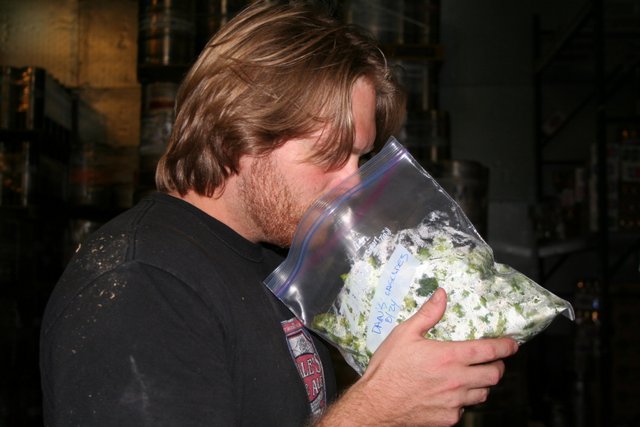
Turbidity of the wort in primary fermentation can have a positive and negative effect on the performance of the yeast. Too much protein break and/or hops in the carboy can clog cell walls making various stages of cell growth and metabolism very difficult and stress the yeast into creating unwanted esters and alcohols. Too little though and you may have issues too. You may lose out on some very helpful Nitrogenous compounds, like amino acids. Also, you may not have any nucleation points to evolve CO2 out of solution and thus elevate the CO2 toxicity. All of this becomes more and more pertinent the higher the gravity of the brew. Key points:
1. Dial in the kettle finings (i.e. Irish moss) and calcium salts in the mash tun. This will help the formation of hot break and cold break. Take a sample of your cold wort and watch soluble protein break out of solution. The simple way to put it is obtain just enough clarity without too much overall protein sediment.
2. Have an effective way to clarify the hot wort post-boil. Whirlpools are effective but require much more thrashing of the wort than necessary if you don’t have pumps to help you out. Whirlpool filters are good, just make sure it’s not too clear, just enough to take out the chunks of trub.
Blenders and wild yeast
Dave Wilson, head of quality assurance
Alaskan Brewing Co. (Juneau, Alaska)
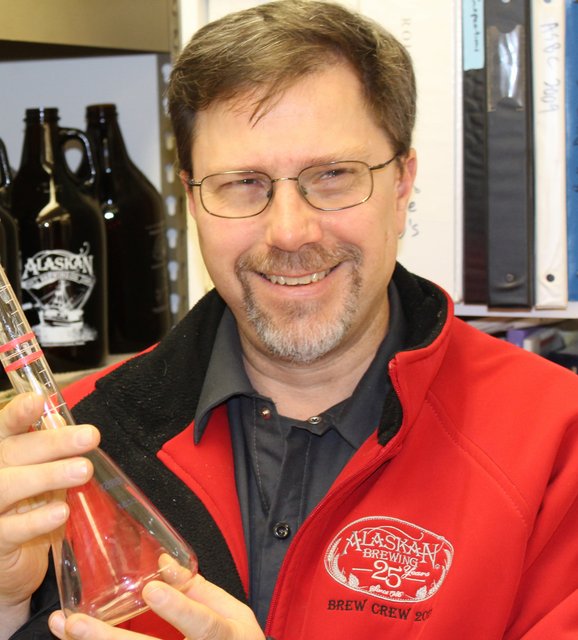
One tool that I have found essential is my KitchenAid blender. I use it for a variety of purposes while brewing, but mostly for its attachments. The mill attachment allows me to get my grain to the perfect consistency, and then also allows for grinding other dry ingredients, like coriander, coffee beans or other spices. And you can use the meat grinder it to grind fruit (cranberries, blueberries, strawberries, jalapenos) for addition to beers, but freeze the fruit first for the best (and less messy) grind. Speaking of fruit, I’ve talked to a lot of homebrewers who don’t realize that fruit additions to brews is a way that wild yeast can be introduced to your beer. To avoid contamination from those wild yeast strains that can be found on a lot of fruit, always flash cook the outside of fruit with hot water — over 100 degrees should kill most yeast strains. Just a minute can help you avoid a wild yeast contamination.
A marriage of art and science
Mark Weinert, brewer
Goose Island Beer Co. (Chicago)

When I first began homebrewing, all I could think about was making the biggest beer that I could muscle out of my not-yet-broken-in-and-incomplete setup. I was eager to fire up my kettle, recreate my favorite beers and create my own masterpieces. I dove in head first. Along the way, I had some decent successes. I also ended up with some odd concoctions that I couldn’t pay people to drink. My spotty successes made me wonder what I was doing wrong, and so I began to educate myself, which brings me to my point: EDUCATE YOURSELF. Read everything that you can get your hands on, from BYO magazine to brewing textbooks to microbiology articles from the brewers association. Knowledge is power. A greater understanding of what is happening in each and every step of your brew day, as well as what is happening in the fermenter, will give you a rock solid foundation on which you can develop great recipes. Brewing is a great marriage of art and science and knowing the science behind your masterpiece makes it that much more attainable.
Just have fun
James “Nick” Nock, head brewer
SweetWater Brewing Co. (Atlanta)
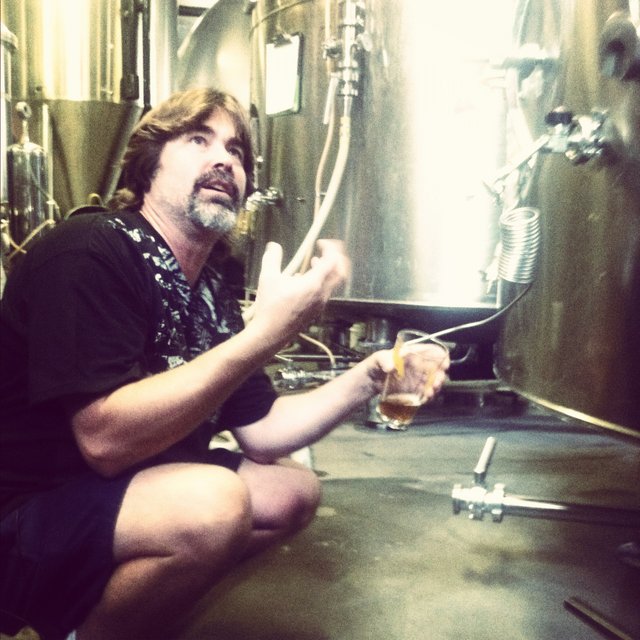
My recommendation on homebrewing is to look at it as a recreational interest. Chances are you will not end up with that huge beautiful brewery on the hill. Do not take it too seriously, have fun with it. Start off simple and get more complex as you master the art. Once you have created a ‘base beer,’ tweak the recipe a little bit each time, by using a different malt, a different yeast strain, a different hop, throwing hops at different times, or add spice or herbs to it. This way you can get a full grasp of each ingredient. Keep a brewer’s log that can be an easy reference in the future. While brewing, make sure everything is properly sanitized. It is not worth it to cut corners. That is the key ingredient in a quality product that represents you.



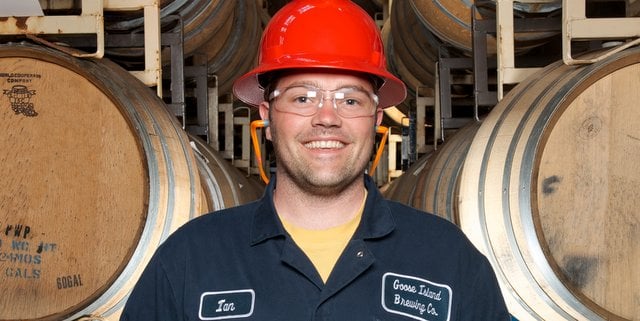
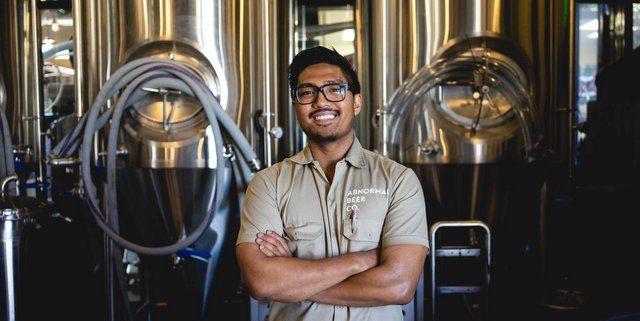
RT @newbelgium: Homebrewer? This is pretty awesome. http://t.co/KvL9lLGzsq
#Homebrewing advice from some of the greats: http://t.co/nwBdnBpv8I I really need to start kegging.
RT @beausallnatural: “Homebrewing Advice from World-Renowned Craft Brewmasters” – Inlcludes tips from Beau’s-own, Matt! http://t.co/IjQ8p1f…
RT @MittenBrewingCo: Working on your homebrewing skills? Check out these tips from @CraftBrewingBiz http://t.co/zFwSiaJTRg #craftbeer #home…
RT @CityTavernDTLA: Homebrewing advice from world-renowned craft brewmasters. http://t.co/LTLSOOH3S1
Homebrewing advice from world-renowned craft brewmasters. http://t.co/LTLSOOH3S1
Useful brewing advice to read for later. http://t.co/J5wThOmu9e
RT @DasAleHaus: Great homebrewing tips from some of the best craft brewers around. I think James Nock has the best advice of all. http://t.…
Great homebrewing tips from some of the best craft brewers around. I think James Nock has the best advice of all. http://t.co/YIPMfPsZEi
Working on your homebrewing skills? Check out these tips from @CraftBrewingBiz http://t.co/zFwSiaJTRg #craftbeer #homebrew #mibeer
Homebrewing advice from world-renowned craft brewmasters http://t.co/7X7h4grfc5 via @craftbrewingbiz
Tips on home brewing from a bunch of people who know something about brewing – http://t.co/rCl2m6H9vM
@massivebrewery #homebrew advice from the likes of @dogfishbeer. Perfrct for those new to all grain brewing 🙂 http://t.co/xHGqoEIp80
RT @NinkasiBrewing: If you homebrew, you MUST read the tips in @CraftBrewingBiz from absolutely phenonemal brewers (including our Jamie)! h…
RT @newbelgium: Homebrewer? This is pretty awesome. http://t.co/G6cbKDiZsH
RT @newbelgium: Homebrewer? This is pretty awesome. http://t.co/KvL9lLGzsq
#Homebrewing advice from the most world-renowned craft brewmasters http://t.co/BLauPxunEs #craftbeer #beer http://t.co/8ScTpiblpS
RT @beausallnatural: “Homebrewing Advice from World-Renowned Craft Brewmasters” – Inlcludes tips from Beau’s-own, Matt! http://t.co/IjQ8p1f…
This is great. Homebrewing Advice from World-Renowned Craft Brewmasters” – http://t.co/xWj6vtYgCA cc: @theepatthomson
RT @beausallnatural: “Homebrewing Advice from World-Renowned Craft Brewmasters” – Inlcludes tips from Beau’s-own, Matt! http://t.co/IjQ8p1f…
Includes tips from our favourite organic beer Beau’s Brewmaster, Matt! http://t.co/KInKsHijy1
@SNAFUBrew RT @CraftBrewingBiz: Homebrewing advice from world-renowned craft brewmasters http://t.co/vRy5Wh0PLz #sundayreading
RT @CraftBrewingBiz: Homebrewing advice from world-renowned craft brewmasters http://t.co/kERpeXN8i2 #sundayreading
RT @beausallnatural: “Homebrewing Advice from World-Renowned Craft Brewmasters” – Inlcludes tips from Beau’s-own, Matt! http://t.co/IjQ8p1f…
RT @beausallnatural: “Homebrewing Advice from World-Renowned Craft Brewmasters” – Inlcludes tips from Beau’s-own, Matt! http://t.co/IjQ8p1f…
RT @beausallnatural: “Homebrewing Advice from World-Renowned Craft Brewmasters” – Inlcludes tips from Beau’s-own, Matt! http://t.co/IjQ8p1f…
RT @beausallnatural: “Homebrewing Advice from World-Renowned Craft Brewmasters” – Inlcludes tips from Beau’s-own, Matt! http://t.co/IjQ8p1f…
“Homebrewing Advice from World-Renowned Craft Brewmasters” – Inlcludes tips from Beau’s-own, Matt! http://t.co/IjQ8p1fGQt @CraftBrewingBiz
RT @CrowdBrewed: Homebrewing advice from world-renowned craft brewmasters http://t.co/JyW09G6lWA #homebrew #homebrewing #craftbeer http://t…
A must read for Homebrewers! – Homebrewing advice from world-renowned craft brewmasters http://t.co/BqurAwprm3
RT @OkellsAles: Homebrewing advice from world-renowned craft brewmasters http://t.co/jmTFrHJ8bo
RT @CraftBrewingBiz: Homebrewing advice from world-renowned craft brewmasters http://t.co/kERpeXN8i2 – A #Thanksgiving Special!
Homebrewing advice from world-renowned craft brewmasters http://t.co/jmTFrHJ8bo
#homebrewing advice from world-renowned craft brewmasters http://t.co/vliEHMpxrI via @craftbrewingbiz
Homebrewing advice from world-renowned craft brewmasters (A Thanksgiving Special!) http://t.co/ZaA3Kn57yy
RT @SpearheadBeer: Homebrewers! Check this out. http://t.co/bsFQaYFvVg
RT @newbelgium Homebrewer? This is pretty awesome. http://t.co/0fNacg9E1o
RT @MYBrewingCo: Homebrewing advice from world-renowned craft brewmasters http://t.co/qXxu3gL9n1 via @craftbrewingbiz
RT @MYBrewingCo: Homebrewing advice from world-renowned craft brewmasters http://t.co/qXxu3gL9n1 via @craftbrewingbiz
Homebrewing advice from world-renowned craft brewmasters http://t.co/qXxu3gL9n1 via @craftbrewingbiz
An interesting read – homebrewing advice from world-renowned craft brewmasters http://t.co/gG0uxGe6au
RT @CrowdBrewed: Homebrewing advice from world-renowned craft brewmasters http://t.co/JyW09G6lWA #homebrew #homebrewing #craftbeer http://t…
RT @newbelgium: Homebrewer? This is pretty awesome. http://t.co/KvL9lLGzsq
RT @NinkasiBrewing: If you homebrew, you MUST read the tips in @CraftBrewingBiz from absolutely phenonemal brewers (including our Jamie)! h…
RT @NinkasiBrewing: If you homebrew, you MUST read the tips in @CraftBrewingBiz from absolutely phenonemal brewers (including our Jamie)! h…
“@newbelgium: Homebrewer? This is pretty awesome. http://t.co/7o5I7CxPOA” Remembering where it all began, and #lovingit #beerbeerbeer
great article #Homebrewing advice from world-renowned craft #brewmasters http://t.co/cqIhYNjPDq
#Homebrewing advice from world-renowned craft #brewmasters http://t.co/cqIhYNjPDq
RT @SpearheadBeer: Homebrewers! Check this out. http://t.co/bsFQaYFvVg
RT @newbelgium: Homebrewer? This is pretty awesome. http://t.co/KvL9lLGzsq
RT @newhollandbrew: @CraftBrewingBiz gets a lot of big craft brewers sharing their best homebrewing tips & tricks! http://t.co/fCBkZVL5MB
RT @OdellBrewing: Hey homebrewers, check out some expert advice from some awesome beer makers, including our very own @raudie_brewer! http…
@CraftBrewingBiz gets a lot of big craft brewers sharing their best homebrewing tips & tricks! http://t.co/fCBkZVL5MB
RT @CrowdBrewed: Homebrewing advice from world-renowned craft brewmasters http://t.co/JyW09G6lWA #homebrew #homebrewing #craftbeer http://t…
RT @CrowdBrewed: Homebrewing advice from world-renowned craft brewmasters http://t.co/JyW09G6lWA #homebrew #homebrewing #craftbeer http://t…
RT @OdellBrewing: Hey homebrewers, check out some expert advice from some awesome beer makers, including our very own @raudie_brewer! http…
Homebrewing advices from some pretty experienced guys. #bru http://t.co/p2GVHJezHU
RT @newbelgium: Homebrewer? This is pretty awesome. http://t.co/KvL9lLGzsq
RT @newbelgium: Homebrewer? This is pretty awesome. http://t.co/KvL9lLGzsq
RT @newbelgium: Homebrewer? This is pretty awesome. http://t.co/KvL9lLGzsq
RT @newbelgium: Homebrewer? This is pretty awesome. http://t.co/KvL9lLGzsq
RT @newbelgium: Homebrewer? This is pretty awesome. http://t.co/KvL9lLGzsq
RT @newbelgium: Homebrewer? This is pretty awesome. http://t.co/KvL9lLGzsq
RT @NinkasiBrewing: If you homebrew, you MUST read the tips in @CraftBrewingBiz from absolutely phenonemal brewers (including our Jamie)! h…
Homebrewing advice from world-renowned craft brewmasters — http://t.co/6sBVKuTEAu
RT @newbelgium: Homebrewer? This is pretty awesome. http://t.co/KvL9lLGzsq
RT @newbelgium: Homebrewer? This is pretty awesome. http://t.co/KvL9lLGzsq
RT @newbelgium: Homebrewer? This is pretty awesome. http://t.co/KvL9lLGzsq
RT @newbelgium: Homebrewer? This is pretty awesome. http://t.co/KvL9lLGzsq
Homebrewing advice from world-renowned craft brewmasters http://t.co/Z2zbnHYiUq via @craftbrewingbiz #beer #craftbeer
“@newbelgium: Homebrewer? This is pretty awesome. http://t.co/8HRh0tpSwZ” @mcfarljo
RT @NinkasiBrewing: If you homebrew, you MUST read the tips in @CraftBrewingBiz from absolutely phenonemal brewers (including our Jamie)! h…
RT @CraftBrewingBiz: Homebrewing advice from world-renowned craft brewmasters http://t.co/kERpeXN8i2 – A #Thanksgiving Special!
Awesome Indeed. RT:”@newbelgium: Homebrewer? This is pretty awesome. http://t.co/FelJZ4TVYg”
Homebrewing advice from world-renowned craft brewmasters http://t.co/7G0RIl5le6
RT @newbelgium: Homebrewer? This is pretty awesome. http://t.co/KvL9lLGzsq
RT @newbelgium: Homebrewer? This is pretty awesome. http://t.co/KvL9lLGzsq
RT @beaus_stuntman: “@newbelgium: Homebrewer? This is pretty awesome. http://t.co/avAbTdLUn0” …This is great! @beausallnatural
RT @newbelgium: Homebrewer? This is pretty awesome. http://t.co/KvL9lLGzsq
RT @newbelgium: Homebrewer? This is pretty awesome. http://t.co/KvL9lLGzsq
http://t.co/HpxhIYXEV2 This article features two of my favorite micro-breweries: @dogfishbeer & @newbelgium. #history #beer
“@newbelgium: Homebrewer? This is pretty awesome. http://t.co/4dGlJZEs4M“@CLEBrewShop
RT @newbelgium: Homebrewer? This is pretty awesome. http://t.co/KvL9lLGzsq
RT @newbelgium: Homebrewer? This is pretty awesome. http://t.co/KvL9lLGzsq
If you homebrew – this is pretty awesome Homebrewing advice from world-renowned craft brewmasters http://t.co/NHSpKNxEZB #beer #untapped
RT @newbelgium: Homebrewer? This is pretty awesome. http://t.co/KvL9lLGzsq
RT @newbelgium: Homebrewer? This is pretty awesome. http://t.co/KvL9lLGzsq
RT @newbelgium: Homebrewer? This is pretty awesome. http://t.co/KvL9lLGzsq
Homebrewers, make sure your next batch comes out perfect (or close enough): http://t.co/H2FUUBQhBe
RT @beaus_stuntman: “@newbelgium: Homebrewer? This is pretty awesome. http://t.co/avAbTdLUn0” …This is great! @beausallnatural
RT @newbelgium: Homebrewer? This is pretty awesome. http://t.co/KvL9lLGzsq
RT @newbelgium: Homebrewer? This is pretty awesome. http://t.co/KvL9lLGzsq
Great tips! RT @CraftBrewingBiz: Homebrewing advice from world-renowned craft brewmasters http://t.co/AJgV1TPZo0 – A #Thanksgiving Special!
RT @CraftBrewingBiz: Homebrewing advice from world-renowned craft brewmasters http://t.co/kERpeXN8i2 – A #Thanksgiving Special!
RT @CraftBrewingBiz: Homebrewing advice from world-renowned craft brewmasters http://t.co/kERpeXN8i2 – A #Thanksgiving Special!
RT @OdellBrewing: Hey homebrewers, check out some expert advice from some awesome beer makers, including our very own @raudie_brewer! http…
Brewery Insurance Program liked this on Facebook.
RT @OdellBrewing: Hey homebrewers, check out some expert advice from some awesome beer makers, including our very own @raudie_brewer! http…
RT @OdellBrewing: Hey homebrewers, check out some expert advice from some awesome beer makers, including our very own @raudie_brewer! http…
Hey homebrewers, check out some expert advice from some awesome beer makers, including our very own @raudie_brewer! http://t.co/dLUnpeqb6E
Homebrewing advice from world-renowned craft brewmasters, such as @sweetwaterbrew’s Nick Nock (not pictured) http://t.co/3AGgTAhMkY
RT @sweetwaterbrew: Check out homebrewing tips from our head brewer Nick Nock in this blog from @CraftBrewingBiz http://t.co/0aDxW62YzY
RT @sweetwaterbrew: Check out homebrewing tips from our head brewer Nick Nock in this blog from @CraftBrewingBiz http://t.co/0aDxW62YzY
Mahalo @craftbrewingbiz cheers and beers! http://t.co/XELVECJAHK
Check out homebrewing tips from our head brewer Nick Nock in this blog from @CraftBrewingBiz http://t.co/0aDxW62YzY